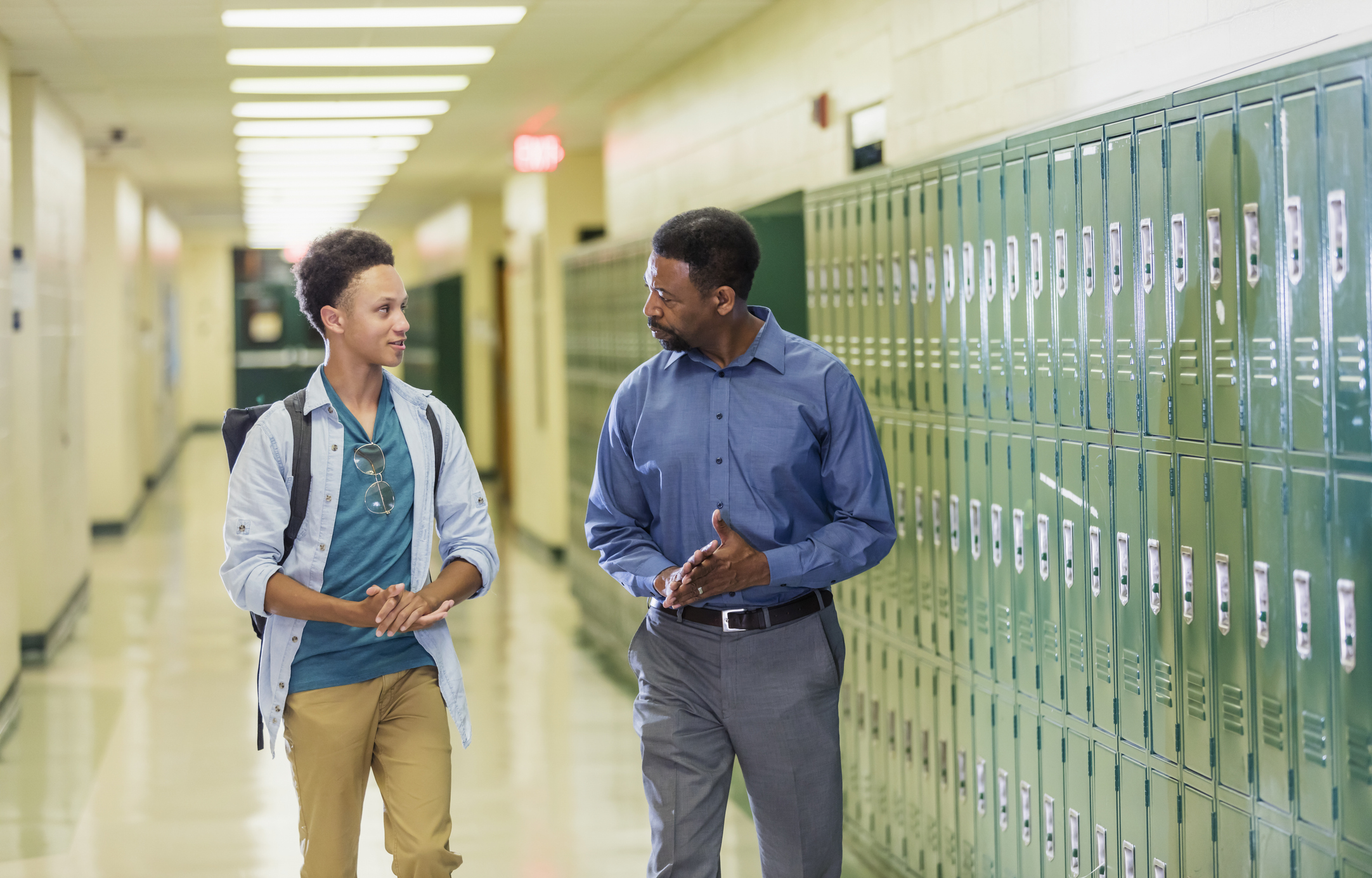
Blue KC, Children’s Mercy Kansas City, and Center School District tackle youth mental health crisis
Center High School teacher Dr. Diana Elkishawi may teach a different math skill in her algebra classes each day, but there’s one activity you may not expect to be in her lesson plan.
“I do a daily check-in with the kids,” Dr. Elkishawi said. “It has helped me be more aware of the kids’ mental health and helped keep myself in check because sometimes I’m not okay and by communicating that with the students, it helped the students cut me some slack.”
The mother of three boys has been teaching math for 17 years, with the last three of those years taking place at Center High School.
“I have always been an advocate of mental health,” she said. “Throughout my time as a student, when I felt the teacher cared, I was more open to receiving advice. I spend a lot of time connecting with the kids and listening to the kids. Sometimes, they want to vent about something in the hallway. You’re dealing with human beings. They’re growing, and they’re trying to find who they are.”
Dr. Elkishawi shared a proud moment from earlier in her career as a teacher on the power that comes with caring about a student.
“There was a student who was failing all the classes and would act out,” she said. “He would get physical with male teachers. The principal asked the student why he didn’t act out in my class. The student said he respected me because I respected him back. He knew I believed in him. I sat him by me. And when I saw what he was capable of, I said to him, ‘Do you know you have an engineering mind? You’re going to come to me one day and say that you’re in engineering school.’ And I kid you not. Seven years later, he comes back to the school and tells the principal he only wants to see Dr. Diana. She brings him upstairs, and he says to me, ‘I came here to tell you one thing. I am in my second year of engineering school.’ I started crying. I was smiling. I use that story to show the way you treat people can either make them or break them.”
Fast forward to January 2024 when Dr. Elkishawi learned about a new mental health initiative that had launched in her district.
“I cannot tell you how happy and honored I am about this movement because I believe in this 200 percent,” she said. “This is so important.”
How this partnership began

“This movement” that Dr. Elkishawi is referring to is a three-year early intervention pilot program that Blue Cross and Blue Shield of Kansas City (Blue KC) and Children’s Mercy Kansas City launched with the Center School District in Kansas City, Missouri, to tackle the mental health crisis among school-aged children.
According to Children’s Mercy Kansas City, more than 15 million children nationwide require mental health services, but many do not receive the care they need. In the Kansas City region, 40-50% of youth go untreated. In 2022, Children’s Mercy Kansas City reported nearly 3,000 assessments in the ER for acute mental health needs.
“When you think about why it’s important to Blue KC, it’s about supporting our community and the future of our community; but more importantly, it really is the overall well-being of our community,” said Dr. Raelene Knolla, Blue KC Vice President of Population Health and Senior Medical Director. “We know that one in five adolescents has a diagnosis of mental or emotional behavioral disorders. It’s trying to find ways to improve that early on. We were having conversations with Children’s Mercy for multiple years about what we can do in the Kansas City metro area with mental well-being and our youth and recognize that it’s been a crisis.”
“When Blue KC and Children’s Mercy got together to say, ‘hey, let’s do something together,’ we essentially had two parameters,” said Robert Steele, MD, Executive VP, Chief Strategy & Innovation Officer at Children’s Mercy Kansas City. “It was we want to do it in mental and behavioral health, and we probably ought to do it within the schools.”
This collaborative effort was created after careful and intentional consideration of the specific needs and strengths of the Center School District, which is comprised of 2,500 students, and designed to improve access to behavioral health education and services in the school setting.
“When we first talked to Center School District Superintendent Dr. Yolanda Cargile, she said we need support for the teachers, the staff and the parents,” Dr. Knolla said. “We need to help support the students in a different way. And we need to educate and train.”
“I am so over ISS (in-school suspension) and OSS (out-of-school suspension),” Dr. Elkishawi said. “Kids belong in the classroom. I’m not saying they shouldn’t be accountable for their actions. But that accountability can happen in a more positive way.”
What are restorative practices?
The pilot program, in part, will incorporate education on and implementation of restorative practice training for the urban school district with the expertise of RestorED. Reggie Berry and Sarah Eblen launched RestorED in 2022 after working as teachers at Southeast High School in the Kansas City Public School District.
The Anti-Bullying Alliance defines restorative practices, which is also known as restorative justice, as a way of working with conflict that puts the focus on repairing the harm that has been done.
“RestorED is not sharing a program,” Berry pointed out. “It’s really a mindset shift that takes individuals to really think about their work, about what they value and what do these values look like in the spaces that they share.”
“The idea is that if a student is misbehaving, that is a sign of a call for help and they actually need more community,” Eblen said. “I think that’s like the aha for folks. It’s like, ‘yeah, every time that I’ve messed up in my life, I’ve had wrap-around people who have said let me lift you back up.’ Not all of our kids have access to wrap-around support in their communities, so how do we make sure that it occurs at school. If they fall, there are hands waiting to lift them back up and not push them literally as they’re already down.”
Center School District Assistant Superintendent Dr. Amy Casey is in her 31st year of being an education professional and has a strong background in restorative work.
“It’s like that idea, ‘Don’t judge a book by its cover,’” she said. “If you are not communicating and talking to one another, you don’t know what that person is really like or what’s important to them. I always say an ounce of prevention is worth a pound of cure. So, part of that restorative work is creating that space and that time up front as an investment rather than having to repair harm on the back end, which is going to take way more time.”
Examples of restorative practices
Now that you know more about what restorative practices means, how exactly will this preventative care model be implemented and what are examples of how it will be put into practice? Here’s a breakdown, beginning with an example from Eblen.
“At the lowest approach of restorative practices, when something occurs like a student is sleeping, instead of saying, ‘that’s a demerit, I’m going to call your parent or I’m moving your clip on the chart, so you have less access to incentives,’ the idea is to teach a skill in that moment, so it sounds like, ‘hey I noticed you’re sleeping. What’s the expectation right now during class?’ Having a student state that and be like, ‘ok cool what does that look like right now? I can have my head up. Awesome. Cool.’ And the idea is like we’re just shifting who has the responsibility in the classroom.”
“Next level is like now we’re having conflict between two individuals,” Berry said. “That could be a student and a student, or a student and a teacher. We like to think about this idea that it’s not like rules are being broken at a time, it’s the relationship that has been fractured. So, we need to find spaces for those individuals to work out their conflict and then come to some resolution. What it looks like is conferencing with the two.”
Berry added: “If conflict keeps rising, we’ve got to get more community involved. We do harm circles where now we’re inviting parents, teachers and two students to share what is their perspective and how it impacted them, what they want and need from their loved ones and what do we need collectively to move forward.”
What will happen during the next three years?
The initiative is currently in Stage 1, which Eblen said is all about learning. All eight Center School District principals have developed a team at each of their schools that is made up of leadership, teachers, and support staff.
“That team is going to be responsible for delivering the training during next school year,” Eblen said. “So, we’re working primarily this year with that team. And by the end of the summer, they will have over 50 hours of restorative training. We started strategically this year so they could get some of those skills and then practice them this year with their students. It’s really just about learning the skills before we think about implementation.”
As part of this initiative, Children’s Mercy Kansas City has also formed and embedded a Behavioral Health Consultation Team to develop a school-based model of support for the district. The Behavioral Health Consultation Team’s work at the systems level will lay the groundwork for restorative practices to thrive.
“They’ve been doing great work getting student, staff, and parent feedback by attending sports games, committee meetings, classroom circles, etc. and working at the systems level to make restorative practices possible,” Eblen said.
“I saw one parent who was extremely enthusiastic about it,” Dr. Elkishawi said. “She believes the way the students handle the situation will help the students in the end. This is why behavior should be handled before academics. When behavior is taken care of, then academics become easy. Our kids are smart kids.”
“The teachers already are feeling very good about how they can improve things,” Dr. Steele said. “I mean that’s really what we have spent a lot of time on. You’ve got to have a critical mass of folks trained. And there’s sort of a train-the-trainer kind of method, so it then disperses throughout the entire school district.”
“We’ll shift into implementation mode in the fall,” Eblen said. “The restorative teams will start doing some training with their staff. Reggie and I will be at schools all next year, helping them with practices, doing some coaching, giving each school some feedback on how are we doing on this practice, where could we see improvement and interviewing students and staff about how they feel about the initial rollout of restorative practices.”
Eblen added: “Then, in that last year with the Blue KC and Children’s Mercy team, we start to shift into checking to see if we are living out our goals of restorative practices. If a student requests a conference, how long does that take? If a staff member wants a conference, how long does that take? Do we hear restorative language in classrooms, or do we still hear exclusionary discipline practices?”
What initiative hopes to accomplish
The goals of the initiative are to proactively support the social and emotional needs of students and teachers with evidence-based behavioral health education and to improve student engagement, attendance, and performance, while simultaneously reducing the incidents of disruptive behavior that often lead to suspension and expulsion.
“I am very excited, hopeful and optimistic about the changes that are going to come from this,” Dr. Knolla said.
“In the future, we want to see suspensions going down,” Berry said. “We want Center to create this system, so they can have conversations to find their way of healing the community.”
“That’s how you get teachers to stay,” Eblen said. “That’s how you decrease teacher turnover, staff turnover and that’s how you keep kids in school. The saddest thing for me ever is that a kid doesn’t have a trusted adult in the building, which means when something occurs, they do not report it. And that’s why this work is important because it’s community work, and every student in the building should say, ‘I have one adult in the building who I can trust with mental health.’”
Eblen added: “In two years of staff using restorative practices at Southeast, the recidivism (students who had five or more discipline reports) reduced 54%,” Eblen said. “So, we know when we have meaningful interventions with students, and we involve them in it instead of doing it to them, they don’t continue to harm a community because now they’re a part of it.”
“Our kids are the heart of our mission,” Dr. Casey said. “They are the reason we are here. And if you want to take the best care of them, you really have to take the best care of our teachers. So, what is beautiful about this is you start there. Start with that leadership, and there is a ripple effect. It’s like throwing that pebble in the pond. It just ripples out. It starts with the leadership, then ripples out to the teachers and then ripples out to the kids and their families.”
“There is always room for improvement, even though I feel like I’m already applying restorative concepts,” Dr. Elkishawi said. “I’m hoping it will give me more of a streamline and more people will follow it. Maybe the training will give me a better understanding of why certain behaviors happen. We’re all excited about the direction this is headed for the sake of the kids.”


